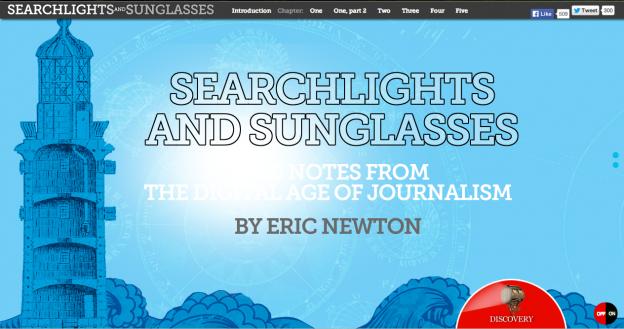Owen Youngman, Knight Professor of Digital Media Strategy at Northwestern University has been using Searchlights and Sunglasses by Eric Newton as a textbook in his classroom. Explore his experiences as you think about texts for your next course and ways innovative forms can invigorate students’ thinking.
Q&A
Why did you decide to use “Searchlights and Sunglasses” in your course?
Youngman: An anecdote might help. Eric Newton gave a talk about the eras of journalism and media, and how to think about the next ones, to a lunch meeting of Knight Chairs a couple of years ago when AEJMC was meeting in Chicago. At the time, I said to myself, ‘There has to be a way to get this in front of journalism students’ — and when the book arrived, there it was, plus all manner of other relevant material about the present and future of journalism from his speeches, research, and thinking. I update the principal readings for my graduate course in media economics, technology, and marketing on a regular basis, and it made sense to incorporate it for the 2013-2014 academic year.
How have you incorporated “Searchlights and Sunglasses” into your course?
Youngman: I assigned specific selections to be read as preparation for, and incorporation into, the final. On the day of the final class, I highlighted four specific passages and had the students answer questions that pushed their ideas into the future. For example, he writes, ‘By 2035, we’ll be in the middle of the era of Intelligent Media. All media will be smart. You’ll carry on conversations with computers … ask them questions, have them do your research. News bots, news drones, robot scribes will be the norm.” Students then answered, “You’ll be in your 40s. How might you exploit such technologies to best inform the public?” A discussion of drones quickly moved to being able to observe and monitor events in remote, underserved and dangerous locations, providing first-hand looks at stories that might otherwise have to rely on second-hand information from the small number of journalists actually on the ground.
In what ways have you seen “Searchlights and Sunglasses” function differently than a typical textbook?
Youngman: For one thing, typical textbooks are published at a point in time and are bound by the choices made at the pub date. In an e-book, Eric obviously can update and improve and correct at will. That will become a norm over the next handful of years, but it is not yet one. The mixture of history, current events, extrapolation, and practical advice specifically for journalism students is unusual. And the fact that much of the book had its genesis in talks and presentations gives it an immediacy and implied interactivity that can keep students reading and thinking, and even get them to go beyond the assigned segments.
What are some of the benefits you saw in using “Searchlights and Sunglasses” in your course?
Youngman: In this particular course, whose elements include intensive study of topics like the privacy expectations between journalists and media companies and their audiences and subjects; the evolving business models for journalism; the ongoing distraction of the audience; social media as a reporting tool, a dissemination mechanism, and a promotional vehicle; the significance of mobile technology and its next manifestations; and branding not only as a means of establishing and maintaining a reputation, but also as a way to assure continued consumption of a journalist’s work, this book provides a great way to sum up the current and near future state of journalism and media without making students re-read other texts from the quarter.
Do you plan on continuing to use “Searchlights and Sunglasses” in your future courses? Why or why not?
Youngman: I certainly will use the book again here at Medill and would expect to continue to do so in courses where its approach and content have the chance to resonate with the students, and where it can be incorporated into the accomplishment of my goals for a given class.
What are some tips you have for other instructors looking to include “Searchlights and Sunglasses” into their courses?
Youngman: Every instructor has different needs and preferences, but I do think the book lends itself to careful excerpting followed by pointed open-ended discussion where students can work through its implications together. As I said earlier, the fact that some of the material came from talks and presentations means that it is particularly well-suited to discussions that help students expand their understanding of the ideas behind the text.
Note: MediaShift received a grant from the Knight Foundation to revamp its EducationShift section and continue the discussion around journalism education begun with “Searchlights and Sunglasses.”
Lauren Simonis is a senior at the University of Wisconsin-Madison studying journalism and English. She is an intern for the EducationShift section at PBS MediaShift. Follow her on Twitter.



